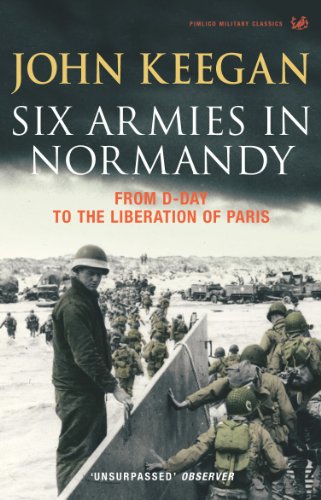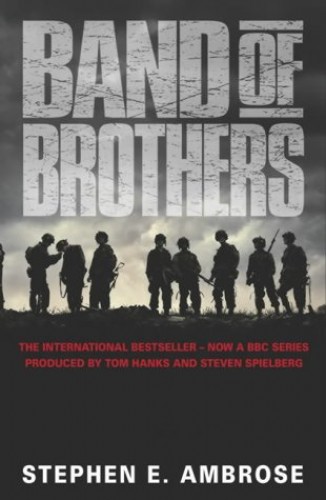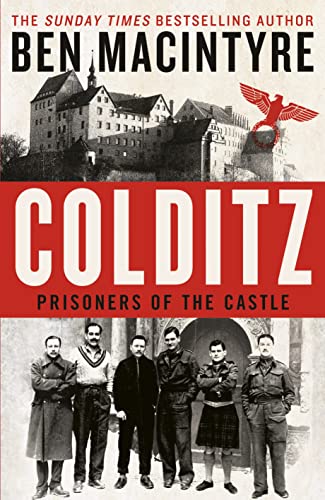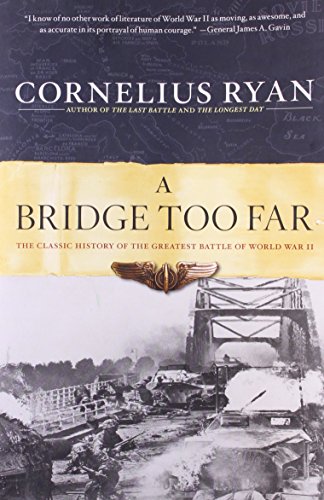This is a list of my top four favourite books about the Second World War.
It is a list in progress but contains some of the titles which first got me into these books. There is a weighting towards Operation Market Garden and D-Day, explained away by my interest in airborne forces but also because my gateway to these books were some of the great Second World War films (As an Amazon Associate I earn from qualifying purchases) A Bridge Too Far and The Longest Day. So here are my choices, let the debate begin:
A Bridge Too Far: Cornelius Ryan – 1974
Where it (possibly) all began for me.
The title comes from a probable apocryphal conversation had during a briefing for Operation Market Garden. I find this, and his other major works, fascinating for several reasons. The main one is the scope of the investigations. In 1941, Cornelius Ryan became the Daily Telegraph’s War Correspondent. He flew along on bombing missions and joined Patton’s Third Army in its battles through Europe.
He got to know many of those involved and was able to tap into this to interview thousands. Many of these stories are interwoven to form this book’s chronological narrative. This also includes the German perspective as well as the Allied.
Yet despite the number of characters, the story does not get lost. As a result of the numerous threads throughout the story, the 1977 Richard Attenborough film of the same name includes performances by many of Hollywood’s big hitters at the time as had The Longest Day in 1962.
Six Armies in Normandy: John Keegan – 1982

John Keegan was also a war correspondent for the Daily Telegraph, before this, he spent 26 years as a lecturer and later the senior lecturer in military history at The Royal Military Academy Sandhurst. He was described as, “among the most prominent and widely read military historians of the late twentieth century”.
Keegan’s interest in the war began at an early age as he was evacuated as a child and as he witnessed the build-up to D-Day. Illness unfortunately meant he was then unfit for military service. This book and others of his were thus prominent in my library when I was studying warfare in the late 1990s.
The book is not just about the strategy of the battle but picks six of the armies which fought it. From the US 101st Airborne, the Canadians at Juno Beach, the build-up and fighting of Operation Epsom by the Scottish, the British tanks in Operation Goodwood, the Mortain counterattack by the Germans and finally the Polish contribution to the Falaise Pocket battle.
Band of Brothers: Stephen E Ambrose – 1992

The TV Series based on this, created, and produced by Steven Spielberg and Tom Hanks, is arguably far more famous than the book itself. Stephen Ambrose is a prolific historian, writing many books on the Second World War and US History. The story of the Easy Company, 506th Regiment of the 101st US Airborne Division, as the subtitle of the book says, from Normandy to Hitler’s Eagles Nest.
It starts the journey as the men of the company begin their training, through their drop on D-Day and their subsequent fights on the Carentan Peninsular. It follows them as they participate in the unsuccessful Operation Market Garden and their successful defence of Bastogne in the Battle of the Bulge.
Their journey then continues into the last few months of the war. They enter Germany and Austria and discover some of the horrors of the Holocaust. They are here when the war in Europe ends and the final chapters deal with the return home for some and what happened to those survivors after the war.
As with many books upon which films and TV series have been made, I often experienced the film or TV series first followed by reading the book. What then followed was the undoubted criticism that the film or TV series had left out loads of the details or added in other details or changed events and characters for dramatic effect. This happened with this book too, but I enjoyed both the book and the following series that made household names of Major Dick Winters and his band of brothers.
An interesting side note, within its pages, there is a short section about Fritz Niland who had lost two brothers on D-Day and another in the Far East. It is upon this little nugget of a story that the premise of Saving Private Ryan would be created. This is the reason why this book is potentially as significant as A Bridge Too Far in my historiography. Saving Private Ryan was the first Second World War film I had seen in the cinema and it convinced me to study films about the war for my MA Thesis.
Colditz: Prisoners of the Castle: Ben Macintyre – 2022
This book is by the author of Rogue Heroes: History of the SAS, Britain’s Secret Special Forces Unit that Sabotaged the Nazis and Changed the Nature of War. It is also the most recently published as well as the book I am currently reading.

So far so good. The number of stories is great and does not just regurgitate the usual narrative. I say this having never read a book specifically about Colditz, so I guess my experience is the more Boys Own stories I heard or read as a child. It’s also interesting as it deals with stories from prisoners of all nationalities and their jailors.
I particularly like the question he sets out to answer with the book, “What would you have done?” It also deals with topics which may have been more taboo or more gritty in earlier works, such as homosexuality, traitors, possible PTSD and suicides.
Final Thoughts
I have tried to explain here why these books are my favourites. I admit that this is a short list and many more could be included. As I read more books, I am sure more favourites will be added to this list, but A Bridge Too Far will remain my number 1. Each of these books will also be reviewed in greater depth in future posts and I welcome your opinions on them too.
Please feel free to comment on my selection and send me your favourites.
In my next post, I will discuss a little more about what I would like this website to become.
T
